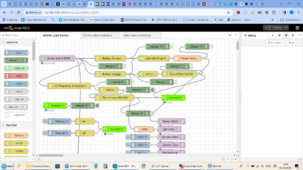AlaskanNoob
Solar Enthusiast
- Joined
- Feb 20, 2021
- Messages
- 913
I've searched and found some discussions, but it seems like this is a mostly untapped thing. Which is strange given all that extra energy that isn't getting used as a result. Down south I'm sure it's no big deal to let all that energy just vanish, but here in Alaska I can definitely use it to help season shift and lengthen our small growing window. Right now I'm sitting here in my cabin with only 2 of our planned 7 arrays up (we'll put the other five up this summer), and I still have feet of snow on the ground and the soil isn't anywhere near planting. At the same time, I can't use all the power that is being produced even on overcast days. I'm using two space heaters (heat pump gets connected here soon) and boiling water in the microwave just to try to see how much PV is coming in but I can't put enough load on to see it and I don't yet have an irradiance sensor.
I have a Victron Quattro and SmartSolar MPPT and make a ton of extra power in the shoulder seasons and summer, and I want to use that power. All of it. Somewhere around 100KWh+ a day worth of extra power. I'll use it to heat sand batteries or water tanks which I can use to extend growing seasons in Alaska or to melt snow along trails or something. I could certainly be growing food with this power being used to melt snow and heat soil.
It seems that the Victron system doesn't know how much PV is available unless there is a load at least as big as the available PV. So if the batteries are full and you have a small household load, the system won't know how much PV is being wasted. So it seems I will need one of those irradiance sensors.
Then I need to make it so that the system uses any power not being used to charge the batteries (so when it's near full and starts throttling the current to top them off or when the batteries are full) or to power household loads, and somehow turn on a DC dump load such that only the extra power is provided to that dump load. I'm not sure how this would be possible, because a load is a load and it would take whatever it could take. But what I desire is taking 25KWh of extra power potentially, and supplying that to a DC bus bar that will have multiple fat cables going to many resistance heating elements to heat sand or water. But if I only have 5KW of extra power, I only want 5KW sent to the DC dump load (all the resistance heaters can split the 5KW). I don't want any time the dump load is turned on, all the resistance heaters trying to take their maximum and thus depleting the batteries.
Is such granular control of the dump load possible? Somebody has to have done it. I'm guessing it will involve Node Red, an irradiance sensor, but I'm not sure what else beyond that.
I have a Victron Quattro and SmartSolar MPPT and make a ton of extra power in the shoulder seasons and summer, and I want to use that power. All of it. Somewhere around 100KWh+ a day worth of extra power. I'll use it to heat sand batteries or water tanks which I can use to extend growing seasons in Alaska or to melt snow along trails or something. I could certainly be growing food with this power being used to melt snow and heat soil.
It seems that the Victron system doesn't know how much PV is available unless there is a load at least as big as the available PV. So if the batteries are full and you have a small household load, the system won't know how much PV is being wasted. So it seems I will need one of those irradiance sensors.
Then I need to make it so that the system uses any power not being used to charge the batteries (so when it's near full and starts throttling the current to top them off or when the batteries are full) or to power household loads, and somehow turn on a DC dump load such that only the extra power is provided to that dump load. I'm not sure how this would be possible, because a load is a load and it would take whatever it could take. But what I desire is taking 25KWh of extra power potentially, and supplying that to a DC bus bar that will have multiple fat cables going to many resistance heating elements to heat sand or water. But if I only have 5KW of extra power, I only want 5KW sent to the DC dump load (all the resistance heaters can split the 5KW). I don't want any time the dump load is turned on, all the resistance heaters trying to take their maximum and thus depleting the batteries.
Is such granular control of the dump load possible? Somebody has to have done it. I'm guessing it will involve Node Red, an irradiance sensor, but I'm not sure what else beyond that.
Last edited:



